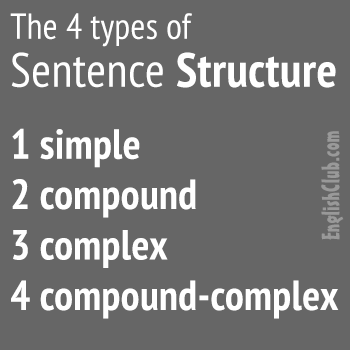
In What is a sentence? we saw the minimum requirements for the formation of a sentence. Now we can look in more detail at the four types of sentence structure.

A simple sentence consists of one independent clause. (An independent clause contains a subject and verb and is structurally complete.)

A compound sentence is two (or more) independent clauses joined by a conjunction or semicolon. Each of these clauses could form a sentence alone.

![]()


There are seven coordinating conjunctions:
Another way to join two independent clauses in a compound sentence uses a semicolon.

![]()

A complex sentence consists of an independent clause plus a dependent clause. (A dependent clause starts with a subordinating conjunction or a relative pronoun, and contains a subject and verb, but is not structurally complete.)


Here are some common subordinating conjunctions:
Here are the five basic relative pronouns:
A compound-complex sentence consists of at least two independent clauses and one or more dependent clauses.


![]()


A dependent clause is also called a subordinate clause.
The above sentences are basic examples only. In some cases other arrangements are possible (for example, a dependent clause can come before an independent clause).
A comma splice is a type of run-on sentence which imitates the structure of a compound sentence, but lacks the necessary pieces (usually the coordinating conjunction).

![]()

This error is a favorite of many students, and you will also see it in loosely-edited professional writing.¹ Because a comma splice is a grammar error and because it leads to a very boring writing style, most careful readers (professors and potential employers) see it as evidence of sloppy writing and poor education.²
This page was adapted from:
"The 4 Types of Sentence Structure" EnglishClub: Learn or Teach English, 2018, https://www.englishclub.com/grammar/sentence/sentence-structure.htm. Accessed 16 May 2018.
The views and opinions expressed in this page are strictly those of the page author.
The contents of this page have not been reviewed or approved by Ashland University.
Revised 7/17/22 • Page author: Curtis Allen • e-mail: callen@ashland.edu.